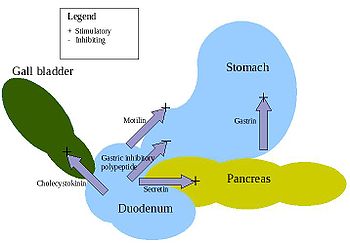APUD cell
Appearance
(Redirected from APUD)

APUD cells (DNES cells) constitute a group of apparently unrelated endocrine cells, which were named by the scientist A.G.E. Pearse, who developed the APUD concept in the 1960s based on calcitonin-secreting parafollicular C cells of dog thyroid.[1] These cells share the common function of secreting a low molecular weight polypeptide hormone. There are several different types which secrete the hormones secretin, cholecystokinin and several others. The name is derived from an acronym, referring to the following:[2][3]
- Amine Precursor Uptake – for high uptake of amine precursors including 5-hydroxytryptophan (5-HTP) and dihydroxyphenylalanine (DOPA).[3]
- Decarboxylase – for high content of the enzyme amino acid decarboxylase (for conversion of precursors to amines).
Cells in APUD system
[edit]- Adenohypophysis
- Neurons of Hypothalamus
- Chief Cells of Parathyroid
- Adrenal Medullary Cells
- Glomus cells in Carotid Body
- Melanocytes of Skin
- Cells of Pineal Gland
- Renin producing cells in the kidney
See also
[edit]- Apudoma
- Enteroendocrine cell
- Neuroendocrine cell
- List of human cell types derived from the germ layers
References
[edit]- ^ Boyd, C. A. R. (March 2001). "Amine uptake and peptide hormone secretion: APUD cells in a new landscape". The Journal of Physiology. 531 (3): 581. doi:10.1111/j.1469-7793.2001.0581h.x. ISSN 0022-3751. PMC 2278499. PMID 11251039.
- ^ Welbourn RB (January 1977). "Current status of the apudomas". Ann. Surg. 185 (1): 1–12. doi:10.1097/00000658-197701000-00001. PMC 1396259. PMID 12724.
- ^ a b Pearse, A.G. (1969). "The cytochemistry and ultrastructure of polypeptide hormone-producing cells of the APUD series and the embryologic, physiologic and pathologic implications of the concept". J. Histochem. Cytochem. 17 (5): 303–13. doi:10.1177/17.5.303. PMID 4143745. S2CID 8240028.
External links
[edit]- APUD+Cells at the U.S. National Library of Medicine Medical Subject Headings (MeSH)
